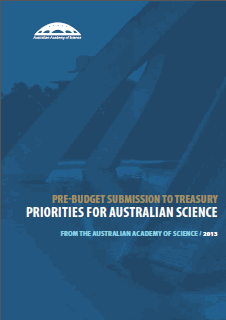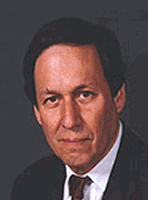|
|
|
|
|
|
|
News & Views item - February 2013 |
![]() Australian Academy of Science Pre-Budget Submission to Treasury. (February
7, 2013)
Australian Academy of Science Pre-Budget Submission to Treasury. (February
7, 2013)
 The
Australian Academy of Science (AAS) yesterday released its 12-page
Pre-Budget Submission to Treasury: Priorities for Australian Science
The
Australian Academy of Science (AAS) yesterday released its 12-page
Pre-Budget Submission to Treasury: Priorities for Australian Science![]() .
.
The Academy summarises its position:
Whatever the specific economic situation facing the Government when
considering the Budget, it is indisputable that Australia must have a
scientifically literate population with high skills and the ability to compete
internationally in many areas of scientific research and tertiary education.
While the Australian Academy of Science is addressing priorities for
consideration as part of the 2013 Budget process, we see the issue of support
for Australian science and science education as far wider and more crucial; we
believe strategic support for science is central to our nation’s future, and our
proposals should be seen in that context.
The Academy has identified seven priorities to inform the preparation of the 2013–14 Federal Budget, to which a commitment is required.
These are abstracted below:
1. Long-term strategic investment in Australian science:
At present, Australia spends 2.2% of its gross domestic product (GDP) — or around $900 per person per year 3 — on research and development (R&D), putting us 13th among OECD member countries, behind Israel, Finland, Korea, Sweden, Japan, and significantly below the OECD average 4. This relatively low level of investment is concerning, when our key competitors are investing relatively more from a relatively worse financial position.
2. Enhanced development and utilisation of our talented research workforce:
We must strive to ensure that we attract and retain skilled scientists and mathematicians in our workforce. The problem must be seen in an international context; in many research fields Australia is but one of several major players, and scientists are willing to move to any country that offers the best research opportunities. [And we must] ensure that every PhD student is exposed to other potential career paths and can develop skills that are needed by employers outside of academia.
3. Further investment in science and maths teaching:
Australia ranks in the bottom half of OECD countries (20th out of 30) when it comes to the per capita number of university graduates emerging with a science or engineering degree. Continued action is needed to raise student participation rates in science and engineering disciplines at the university level. [Furthermore,] we need a scientifically literate community because many of the complex challenges facing Australia over the coming decades will require the community as a whole to be able to assess scientific argument and technical data.
4. Augmentation of international science linkages: a strategic investment to meet the challenges of the ‘Asian Century’:
The 2012 Australia in the Asian Century White Paper recognises that international scientific collaborations are crucial to Australia’s future prosperity and relevance internationally. The paper states that partnerships with international science communities, particularly in Asia, are crucial to supporting Australia’s ability to access and share new ideas and build future competitiveness, and that partnerships must be strengthened if we are going to be able to benefit from Asia’s growth as a global science and innovation hub... we are in danger of being left out of future scientific collaborations.
5. Ongoing investment in major research infrastructure:
Research infrastructure is a foundation investment — without the requisite equipment and skilled technical expertise required to operate it, research in many critical disciplines simply cannot move forward. Nor can we provide the education and training environment for the workforce needed to underpin Australian research, Australian innovation and Australian industry.
[A]bsence of continuing funding is creating uncertainties that are already leading researchers and highly skilled technicians to move on to other opportunities,… a replacement program is needed to get the best possible research outcomes from existing infrastructure.
6. Provision of true research costs:
When research programs are undertaken, they should be properly assessed and budgeted and the programs should be fully supported to the extent required to achieve the project outcomes. [Currently ARC and NHMRC] grants do not cover the full cost of research. It takes at least 60 cents for each research grant dollar to cover the indirect or hidden costs such as providing serviced lab space, IT and computing equipment and support, library facilities, insurance, and administrative support.
7. Improvement of research productivity by reducing administrative burden:
Recent estimates have calculated that the average researcher spends up to 35% of his/her working time on bureaucratic and administrative tasks, which include preparing grant applications and complying with reporting requirements. It is universally held that the level of bureaucracy has increased markedly over the past ten years due to a proliferation of new regulations and poorly designed grant application formats.
Each of the seven priorities concludes with the Academy's proposals in broad outline for the corrective measures to be taken.
And its overarching conclusion?
In a Federal Budget of some $375 billion dollars, in a country universally envied for its escape from the international financial crises of the past decade, an expenditure of less than $9 billion on R&D does not come close to meeting the long-term needs of Australia. We believe that funding should enable policy, not the other way round. The Australian Academy of Science urges the Government to take strategic decisions in this Budget that will create an environment of research growth over the coming two to three decades, providing input into new science-based industries, strengthening our universities, and fostering close links with growing powers in our region. The Academy proposes these priorities in the context of the implementation of reforms within the Australian research sector that will guarantee rapid and positive responses to new challenges, and we will support Government moves to encourage these reforms. The fundamental key to a strong Australian economy over the coming century must be a consistent and committed strategic investment in the people and facilities that comprise our research strength and our international contribution to science.

The Academy's science policy secretary, Professor Bob Williamson, told The Australian's Jill Rowbotham: "...it is more than money: we need more politicians and public servants to come from the ranks of scientists and technologists. Only 11 members of federal parliament has a science or medical qualification, far fewer than most countries."
And he continued: "The real question is, in what way can Australia take advantage of this wonderful period of prosperity which is based upon our mineral wealth and our natural resources to prepare ourselves for a future when they run out, but we still need to be a research-based science and technology literate country. We look at countries like Norway which are using the money they are getting from natural resources to invest in education, research and technology. Why is Australia not making an equivalent commitment at this time for the period in 20 or 30 years when the iron ore will run out?
"It's too important to become a electoral football, we need a national policy that involves everyone in politics."